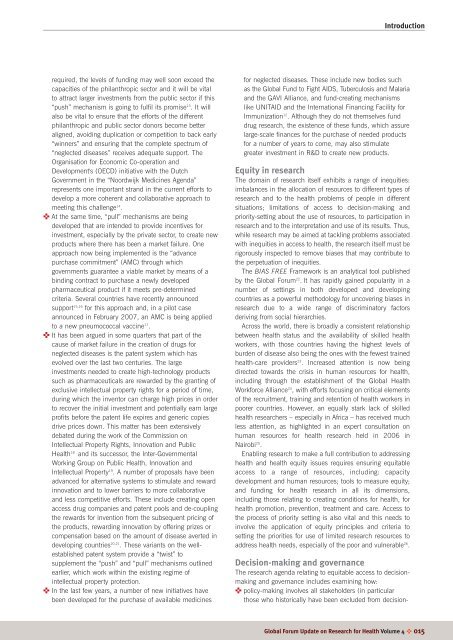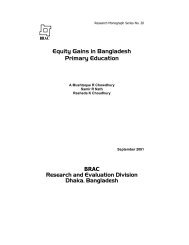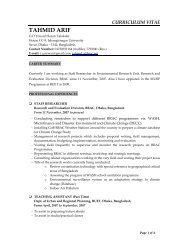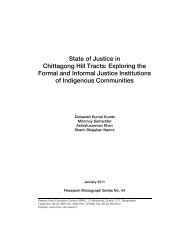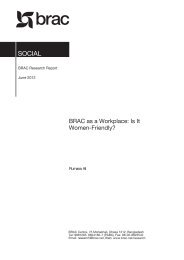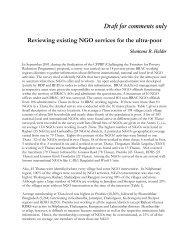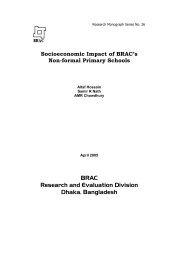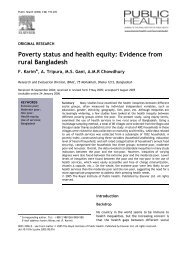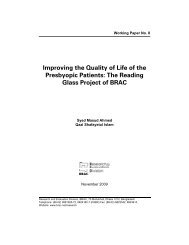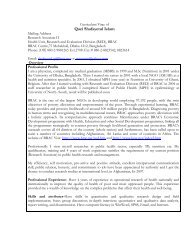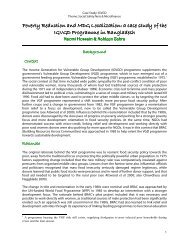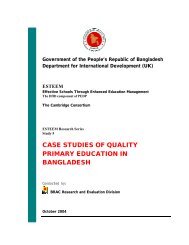Combining health and social protection measures to reach the ultra ...
Combining health and social protection measures to reach the ultra ...
Combining health and social protection measures to reach the ultra ...
You also want an ePaper? Increase the reach of your titles
YUMPU automatically turns print PDFs into web optimized ePapers that Google loves.
Introduction<br />
required, <strong>the</strong> levels of funding may well soon exceed <strong>the</strong><br />
capacities of <strong>the</strong> philanthropic sec<strong>to</strong>r <strong>and</strong> it will be vital<br />
<strong>to</strong> attract larger investments from <strong>the</strong> public sec<strong>to</strong>r if this<br />
“push” mechanism is going <strong>to</strong> fulfil its promise 13 . It will<br />
also be vital <strong>to</strong> ensure that <strong>the</strong> efforts of <strong>the</strong> different<br />
philanthropic <strong>and</strong> public sec<strong>to</strong>r donors become better<br />
aligned, avoiding duplication or competition <strong>to</strong> back early<br />
“winners” <strong>and</strong> ensuring that <strong>the</strong> complete spectrum of<br />
“neglected diseases” receives adequate support. The<br />
Organisation for Economic Co-operation <strong>and</strong><br />
Development's (OECD) initiative with <strong>the</strong> Dutch<br />
Government in <strong>the</strong> “Noordwijk Medicines Agenda”<br />
represents one important str<strong>and</strong> in <strong>the</strong> current efforts <strong>to</strong><br />
develop a more coherent <strong>and</strong> collaborative approach <strong>to</strong><br />
meeting this challenge 14 .<br />
✜ At <strong>the</strong> same time, “pull” mechanisms are being<br />
developed that are intended <strong>to</strong> provide incentives for<br />
investment, especially by <strong>the</strong> private sec<strong>to</strong>r, <strong>to</strong> create new<br />
products where <strong>the</strong>re has been a market failure. One<br />
approach now being implemented is <strong>the</strong> “advance<br />
purchase commitment” (AMC) through which<br />
governments guarantee a viable market by means of a<br />
binding contract <strong>to</strong> purchase a newly developed<br />
pharmaceutical product if it meets pre-determined<br />
criteria. Several countries have recently announced<br />
support 15,16 for this approach <strong>and</strong>, in a pilot case<br />
announced in February 2007, an AMC is being applied<br />
<strong>to</strong> a new pneumococcal vaccine 17 .<br />
✜ It has been argued in some quarters that part of <strong>the</strong><br />
cause of market failure in <strong>the</strong> creation of drugs for<br />
neglected diseases is <strong>the</strong> patent system which has<br />
evolved over <strong>the</strong> last two centuries. The large<br />
investments needed <strong>to</strong> create high-technology products<br />
such as pharmaceuticals are rewarded by <strong>the</strong> granting of<br />
exclusive intellectual property rights for a period of time,<br />
during which <strong>the</strong> inven<strong>to</strong>r can charge high prices in order<br />
<strong>to</strong> recover <strong>the</strong> initial investment <strong>and</strong> potentially earn large<br />
profits before <strong>the</strong> patent life expires <strong>and</strong> generic copies<br />
drive prices down. This matter has been extensively<br />
debated during <strong>the</strong> work of <strong>the</strong> Commission on<br />
Intellectual Property Rights, Innovation <strong>and</strong> Public<br />
Health 18 <strong>and</strong> its successor, <strong>the</strong> Inter-Governmental<br />
Working Group on Public Health, Innovation <strong>and</strong><br />
Intellectual Property 19 . A number of proposals have been<br />
advanced for alternative systems <strong>to</strong> stimulate <strong>and</strong> reward<br />
innovation <strong>and</strong> <strong>to</strong> lower barriers <strong>to</strong> more collaborative<br />
<strong>and</strong> less competitive efforts. These include creating open<br />
access drug companies <strong>and</strong> patent pools <strong>and</strong> de-coupling<br />
<strong>the</strong> rewards for invention from <strong>the</strong> subsequent pricing of<br />
<strong>the</strong> products, rewarding innovation by offering prizes or<br />
compensation based on <strong>the</strong> amount of disease averted in<br />
developing countries 20,21 . These variants on <strong>the</strong> wellestablished<br />
patent system provide a “twist” <strong>to</strong><br />
supplement <strong>the</strong> “push” <strong>and</strong> “pull” mechanisms outlined<br />
earlier, which work within <strong>the</strong> existing regime of<br />
intellectual property <strong>protection</strong>.<br />
✜ In <strong>the</strong> last few years, a number of new initiatives have<br />
been developed for <strong>the</strong> purchase of available medicines<br />
for neglected diseases. These include new bodies such<br />
as <strong>the</strong> Global Fund <strong>to</strong> Fight AIDS, Tuberculosis <strong>and</strong> Malaria<br />
<strong>and</strong> <strong>the</strong> GAVI Alliance, <strong>and</strong> fund-creating mechanisms<br />
like UNITAID <strong>and</strong> <strong>the</strong> International Financing Facility for<br />
Immunization 12 . Although <strong>the</strong>y do not <strong>the</strong>mselves fund<br />
drug research, <strong>the</strong> existence of <strong>the</strong>se funds, which assure<br />
large-scale finances for <strong>the</strong> purchase of needed products<br />
for a number of years <strong>to</strong> come, may also stimulate<br />
greater investment in R&D <strong>to</strong> create new products.<br />
Equity in research<br />
The domain of research itself exhibits a range of inequities:<br />
imbalances in <strong>the</strong> allocation of resources <strong>to</strong> different types of<br />
research <strong>and</strong> <strong>to</strong> <strong>the</strong> <strong>health</strong> problems of people in different<br />
situations; limitations of access <strong>to</strong> decision-making <strong>and</strong><br />
priority-setting about <strong>the</strong> use of resources, <strong>to</strong> participation in<br />
research <strong>and</strong> <strong>to</strong> <strong>the</strong> interpretation <strong>and</strong> use of its results. Thus,<br />
while research may be aimed at tackling problems associated<br />
with inequities in access <strong>to</strong> <strong>health</strong>, <strong>the</strong> research itself must be<br />
rigorously inspected <strong>to</strong> remove biases that may contribute <strong>to</strong><br />
<strong>the</strong> perpetuation of inequities.<br />
The BIAS FREE Framework is an analytical <strong>to</strong>ol published<br />
by <strong>the</strong> Global Forum 22 . It has rapidly gained popularity in a<br />
number of settings in both developed <strong>and</strong> developing<br />
countries as a powerful methodology for uncovering biases in<br />
research due <strong>to</strong> a wide range of discrimina<strong>to</strong>ry fac<strong>to</strong>rs<br />
deriving from <strong>social</strong> hierarchies.<br />
Across <strong>the</strong> world, <strong>the</strong>re is broadly a consistent relationship<br />
between <strong>health</strong> status <strong>and</strong> <strong>the</strong> availability of skilled <strong>health</strong><br />
workers, with those countries having <strong>the</strong> highest levels of<br />
burden of disease also being <strong>the</strong> ones with <strong>the</strong> fewest trained<br />
<strong>health</strong>-care providers 23 . Increased attention is now being<br />
directed <strong>to</strong>wards <strong>the</strong> crisis in human resources for <strong>health</strong>,<br />
including through <strong>the</strong> establishment of <strong>the</strong> Global Health<br />
Workforce Alliance 24 , with efforts focusing on critical elements<br />
of <strong>the</strong> recruitment, training <strong>and</strong> retention of <strong>health</strong> workers in<br />
poorer countries. However, an equally stark lack of skilled<br />
<strong>health</strong> researchers – especially in Africa – has received much<br />
less attention, as highlighted in an expert consultation on<br />
human resources for <strong>health</strong> research held in 2006 in<br />
Nairobi 25 .<br />
Enabling research <strong>to</strong> make a full contribution <strong>to</strong> addressing<br />
<strong>health</strong> <strong>and</strong> <strong>health</strong> equity issues requires ensuring equitable<br />
access <strong>to</strong> a range of resources, including: capacity<br />
development <strong>and</strong> human resources; <strong>to</strong>ols <strong>to</strong> measure equity;<br />
<strong>and</strong> funding for <strong>health</strong> research in all its dimensions,<br />
including those relating <strong>to</strong> creating conditions for <strong>health</strong>, for<br />
<strong>health</strong> promotion, prevention, treatment <strong>and</strong> care. Access <strong>to</strong><br />
<strong>the</strong> process of priority setting is also vital <strong>and</strong> this needs <strong>to</strong><br />
involve <strong>the</strong> application of equity principles <strong>and</strong> criteria <strong>to</strong><br />
setting <strong>the</strong> priorities for use of limited research resources <strong>to</strong><br />
address <strong>health</strong> needs, especially of <strong>the</strong> poor <strong>and</strong> vulnerable 26 .<br />
Decision-making <strong>and</strong> governance<br />
The research agenda relating <strong>to</strong> equitable access <strong>to</strong> decisionmaking<br />
<strong>and</strong> governance includes examining how:<br />
✜ policy-making involves all stakeholders (in particular<br />
those who his<strong>to</strong>rically have been excluded from decision-<br />
Global Forum Update on Research for Health Volume 4 ✜ 015


